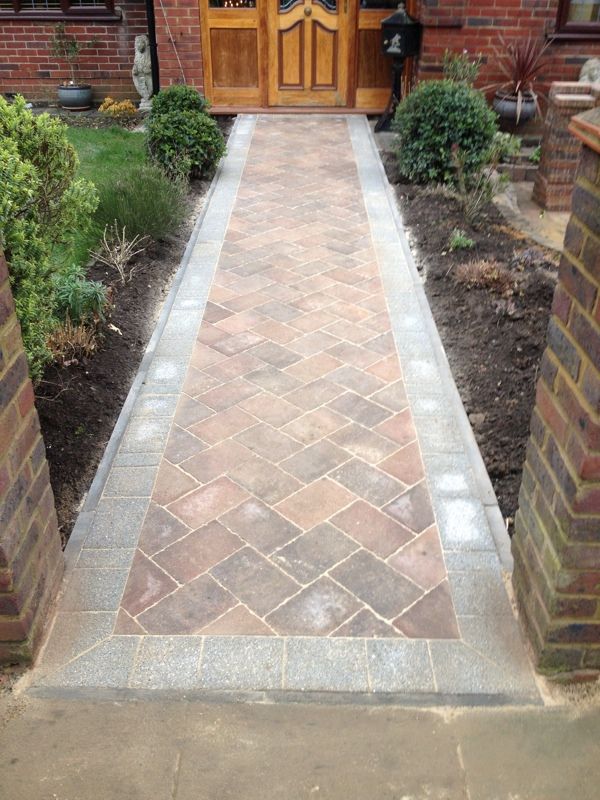Page 2 of 2
Posted: Fri Jan 24, 2014 9:17 am
by kariba
you guys are so full of knowledge 
Posted: Fri Jan 24, 2014 9:45 am
by Tony McC
Well, we're definitely full of something! :p
Posted: Fri Jan 24, 2014 2:53 pm
by kariba
haha so setting out narrow paths to avoid darts and slips....where do i start. I used to set it up like the op's path.
Do you know what it feels like to find out you're not a classy contractor? oh wait, no you don't

Posted: Fri Jan 24, 2014 3:22 pm
by kariba
don't worry about that, I just got off my arse and walked outside!
Posted: Fri Jan 24, 2014 4:21 pm
by Edgar
Tony McC wrote:But with most narrow paths, you should be able to set out so that darts and slips are avoided.
I know customers often insist upon it, but I never liked the use of 45° herringbone on narrow paths. It's so labour intensive and so wasteful. A bit of deterrent pricing can often persuade them to switch for 90° HB or even a simple transverse stretcher. If you;re charging, say, 70 quid a metre for normal driveway/courtyard areas, then 120 quid/m² for paths less than 1200mm in width seems reasonable.
That I agree with. It's the herringbone design that's the mistake. But people seem to like it (why?) and if that's what they want I think it looks best with the little triangular bits at the edges.
Maybe the answer is to explain to potential customers that if they want herringbone they have to accept it may not be so durable.
Personally I don't like herringbone at all. When I had my drive (a 'Y' shaped drive and parking area) done a few years ago I chose a straight across design using the three sizes of Marshalls Argent blocks. It isn't perfect - your site has shown me the kinds of things that could have been better - but I'm delighted with it. We no longer get muddy feet or grit in the hall, and I can mend my cars much more comfortably. I've been very surprised to get many admiring comments from callers and passers-by. One day I'll decide to get the worst bits relayed - perhaps.
Thank you Tony for this wonderful site.
Edgar
Posted: Sat Jan 25, 2014 11:23 am
by Tony McC
Herringbone is the strongest bond pattern for rectangular blocks because it is 'locked' in both transverse and longitudinal directions. See the Herringbone Pattern page. Some people (and I include meself) think that, on particular projects, a 45° orientation for the herringbone shows it to its best advantage, but where you have awkwardly shaped areas to pave, it can be more trouble than it's worth.
Regarding my comments on positioning, look at the sketch below. In the top part, an 800mm wide path has just been plonked down anywhere and the result is a series of traingular darts on the LH edge and and series of compliant, but awkward-to-cut pieces on the right.
By shifting the position of the very same pattern, as shown in the lower part of the drawing, we get larger, easier-to-cut pieces to both edges.
A little bit of planning and forethought can often ensure you get the best results, even from these nightmare paths!

Posted: Sat Jan 25, 2014 1:42 pm
by lutonlagerlout
with a 1200 wise path large tegula herringbone works great with a 140 border and big cuts both sides
like so

cheers LLL
Posted: Sat Jan 25, 2014 6:35 pm
by Edgar
Thanks for the explanation about the strength of herringbone when done correctly. That's probably why I see so much herringbone work about in garden centres and large paved areas. But I wonder how many design their driveways with that degree of care when narrow paths are included.
LLL's excellent example has 3 triangular blocks. Would it have been possible to have had none without spoiling the appearance? It's also a path on its own unconnected to a larger area.
In Tony's diagram there would be triangles if the path stopped at either the end of borders.
I suppose what I don't like is inboard cutting done without thought to the appearance just to comply with the 4 sides rule. I personally would prefer to have it looking good even if it was less strong.
My own drive is done in straight rows of blocks and has quite a few small bits at the curved edges. You wouldn't like it and even I can see how it could have been better. It won't be in the Marshalls catalogue. But I'm pleased with it.
Posted: Sun Jan 26, 2014 11:18 am
by Tony McC
Done correctly, inboard cutting need not compromise aesthetics. I'm a pedant when it comes to paving, preferring it to be structurally correct rather than superficially pretty, especially if it's my own drive beacuse that is, effectively, a showpiece for my skills. If clients or other contractors were to see my drive and think I'd skimped on summat, or cut corners, or not complied on my own property, how would I behave on someone else's job?
The number who *do* design their driveways with this degree of care are few, I'll admit, but they do tend to be the ones who win the awards and the best paying jobs precisely because they *have* put in that degree of care and planning.
But inboard cutting is always a compromise. It's virtually impossible to exclude every triangle, every slip or dart, but the point is to minimise their use as far as possible, which is exactly what LLL did with his gorgeous path. Inboard cutting is part of the British Standard for a very good reason: it makes for better performing, longer lasting pavements. That's why it's considered "best" practice. Not "mediocre" practice or "it'll do" practice, and definitely not "rigidly-enforced compulsory" practice. Just best practice. 


